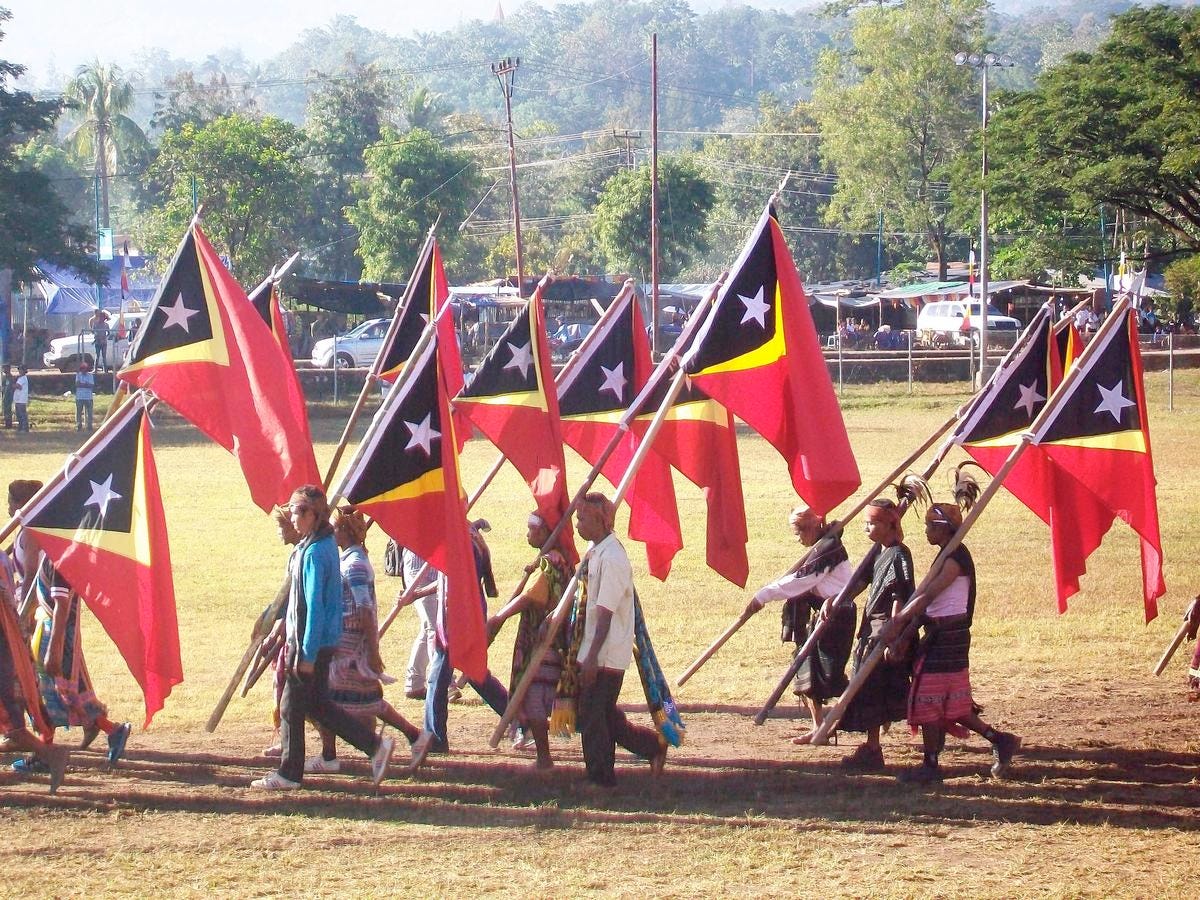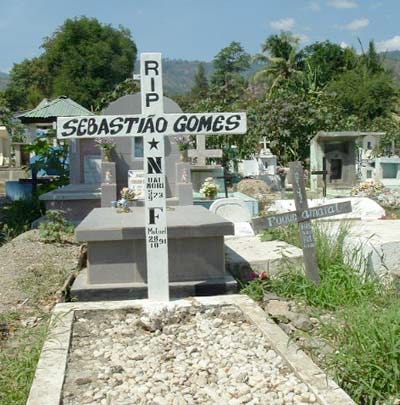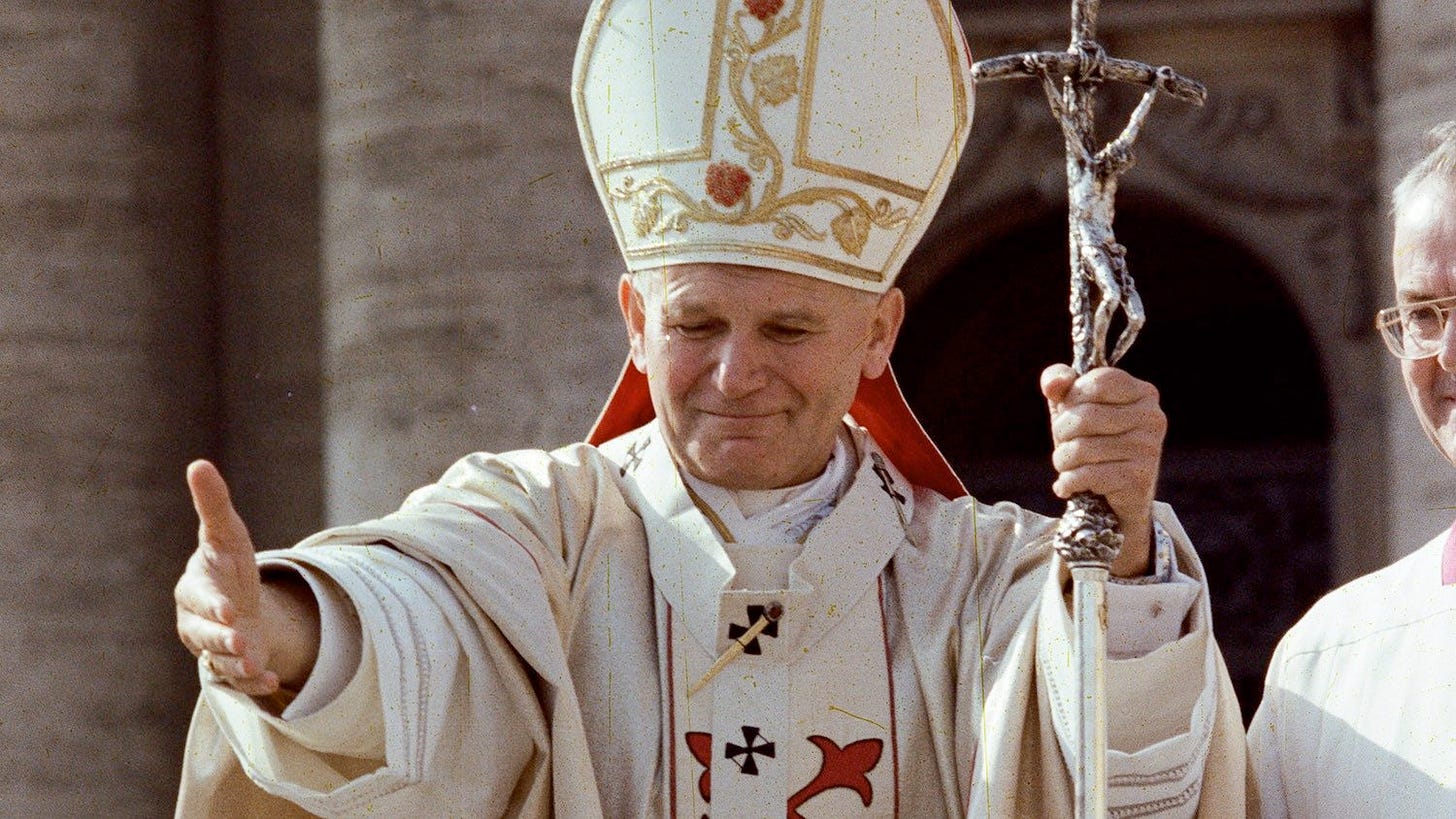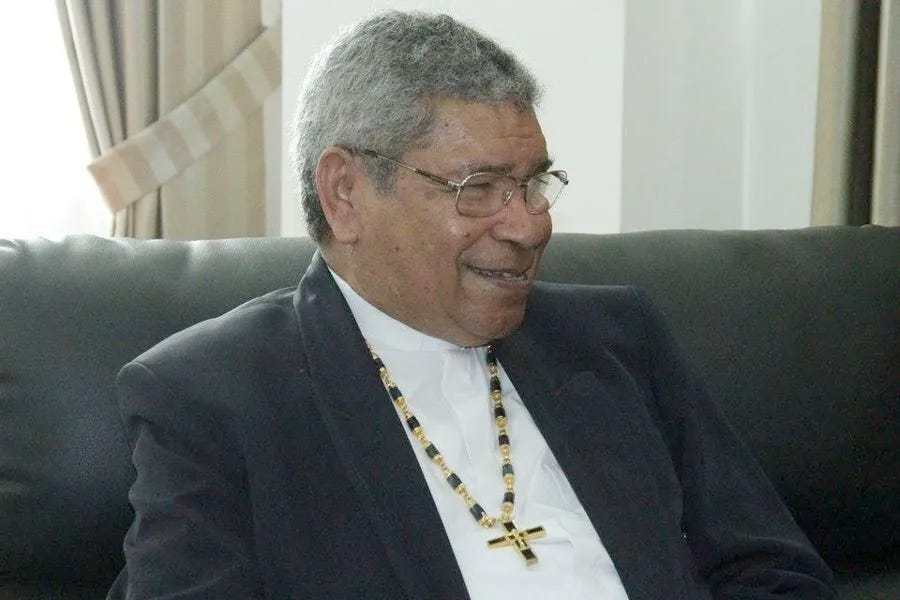
Crocodile tears: How East Timor became an unlikely Catholic stronghold
From colony to occupied territory to independent nation, the Church - and papal diplomacy - have helped shape Asia's most Catholic country
As part of his long trip to Asia and Oceania, Pope Francis will be visiting the small nation of East Timor from September 9 to 11 — the second visit of a pope to the territory, but the first since East Timor was formally recognized as independent in 2002.

While small as a nation, East Timor is in fact the most Christian country in Asia, with around 90% of the population professing Catholicism (the Christian population of the Philippines is bigger in real terms, but lower in percentage), which could explain the pope’s trip.
But a look at the recent history of the region shows that the connection between the Church and the East-Timorese goes much deeper than simple demographics.
In 1930 the population of East Timor was around 4% Catholic. By the 1970s, after the Church invested heavily in education and mission, that increased to about 30%. Then, in the space of a decade after 1975, the Catholic population exploded to 85%.
So, what happened in East Timor to make that Catholic growth possible?
Why is East Timor, just half of one island in the Indonesian archipelago, an independent country at all? And what was the Church’s role in shaping its national identity and helping it reach independence in 2002?
Local legend has it that the island of Timor was formed when a giant crocodile sacrificed itself to form an island as a home for a young boy.
East Timor became a Portuguese colony in 1596, and the accompanying Portuguese missions had some success among the native inhabitants — especially amongst the local rulers, or liurai.
Brother Jerome, now an Orthodox monk, but formerly known as Luís Filipe Thomaz, is a Portuguese historian of religion and linguist, who lived in East Timor for several years and has visited several times.
Jerome told The Pillar that “in 1702, when the [new] Portuguese governor arrived, he carried gifts for the liurai, and there is a record of that. What is interesting is to note that at that time all of these local rulers already had Christian names and Portuguese surnames, they had all converted to Catholicism.”
More than 270 years later, though, the faith had still failed to take hold among the majority of the population, which remained animist, while the majority of their Indonesian neighbors, in the rest of the archipelago, were Muslim.
The turning point, ironically, seems to have been when the Portuguese, following the 1974 Carnation Revolution in Lisbon that put an end to the ruling dictatorship and suddenly granted independence to all of their overseas colonies.
The departure of the Portuguese from Timor was hasty and badly-planned. With a fledgling left-wing independence movement poised to take over, Indonesia invaded East Timor and officially annexed the half-island. With an overwhelming military force, the Timorese had no chance of resisting the Indonesians on the battle-field, but they adamantly refused to be assimilated.
“They did already have their own culture, so there was some structural resistance, but the Indonesians came in killing,” Brother Jerome told The Pillar.
“The uncle of Basílio Nascimento, who would later become the Bishop of Baucau, was a nurse, and when he saw the carnage, he went to the hospital to help care for the wounded. The Indonesians let him do so, but then killed him, so that he could not witness to what he had seen.”
“Then they rounded up the population of the capital, Dili, and took those they could down to the docks. They lined up 50 people by the waterside and machine gunned them, saying that this is what would happen to anybody who challenged Indonesian rule,” recalled Brother Jerome, who had himself left the island only three years earlier, after completing his military service and staying on for another year as a teacher in the local seminary.
“Years later, when I visited again, I saw the seminary, which was reduced to rubble. The Indonesians suspected it might be housing resistance members and bombed it. It used to be the best-equipped library in the land, but they didn’t even spare the books, many of which were sliced in half by shrapnel,” he said.
Besides the revulsion caused by Indonesia’s heavy-handedness, another factor contributed to driving up the Christian population. Indonesia only allows its citizens to belong to one of five officially recognized religions, animism and ancestor-worship were not included. Given the options of Islam, Hinduism, Buddhism, Confucianism, Protestantism and Catholicism, the Timorese gravitated towards what they were already familiar with, and with what was already the religion of their traditional rulers.
“The priests administered the rites of admission to the catechumenate to many people, but only baptized them after further catechesis”, said Br. Jerome.
Father Joaquim Sarmento, the head of the Jesuit order in East Timor, who will be serving as the pope’s official translator during the visit, adds that this was also a time of growth for the Church at a different level.
“The Church grew in numbers, but also in identity. It became a friend, a companion to the people, in the fight for the values of the Kingdom, to standing with the oppressed,” he told The Pillar.
While a tiny band of guerrillas kept up the fight against the Indonesians in the mountains and jungles, the real spirit of resistance was kept alive by the Church.
“The Church provided a philosophical backbone to the resistance movement, making it about more than just violence, but also about freedom and rights,” said Fr Sarmento.
“And it gave the Timorese hope that one day the values of the Kingdom would prevail in East Timor, and that the difficult days would end. But the relationship between the Church and the resistance was very strong, very intense. The Church was one of the only credible institutions that existed at the time, and it was well-organized, reaching even the most distant neighborhoods.”
Portugal protested against the invasion of what was still officially its territory, but Indonesia was a valued ally of the West during the time of the Cold War, so little international attention was paid to the issue of the invasion. For 25 years the Timorese lived under extreme persecution and in an environment of great fear.
“I was only eight when the Indonesians invaded, but I remember having to flee into the jungle to hide,” said Fr Sarmento, who after the invasion eventually went to Indonesia to pursue priestly formation.
Fr Constâncio Gusmão, a Timorese priest who had moved to Portugal to study before the Indonesian invasion, kept close contact with his family during the Indonesian occupation and even managed to visit the territory. “There were many terrible things during the Indonesian invasion, but everything reached us in whispers, because everybody was afraid, there was a constant fear that someone might denounce you to the Indonesians,” he told The Pillar.
“But still, people protested, and the priests cooperated, including with the guerrillas.” Fr Gusmão himself managed to meet with the armed resistance during his visit to occupied Timor.
Roman diplomacy
As the Cold War drew to an end, Indonesia stopped carrying the strategic credit it once had with the West and incidents such as the 1983 Kraras massacre, in which the Indonesian military killed around 200 Timorese civilians in what came to be known as the Valley of the Widows, began to be noticed and reported on by Human Rights organizations.
More people began to pay attention to the plight of the Timorese, but a pivotal event came in 1989, when Pope John Paul II visited Indonesia, stopping in East Timor for a few hours on 12 October.
The pope’s visit would become a classic example of Vatican diplomacy at work. East Timor was not the only Catholic part of Indonesia, and there was grounded fear that any overt gesture by the pope in favor of the Timorese cause would lead to repercussions for the Church in general in Indonesia.
The Holy See was criticized for staging a visit to what was, legally speaking, occupied territory – the United Nations had not recognized the annexation of East Timor by Indonesia, and from the perspective of international law it was still considered a Portuguese colony – but with a series of discrete gestures, John Paul II made it clear he was not supporting Jakarta’s claims to the region.
Henrique Mota was editor-in-chief of a Catholic radio station in 1989, and made the trip with John Paul II.
“I traveled with a colleague from Lusa, the Portuguese state news agency, and this was not irrelevant, because on any Papal trip, besides the Vaticanists who generally travel with the pope, there is always a number of seats reserved for journalists from the visited countries, and the Holy See included us among the latter,” he told The Pillar.
“Also, when the pope left Rome, the Portuguese ambassador was present on the runway to say goodbye, also in the capacity of ambassador of a visited country, and then the Vatican press director [Joaquín] Navarro Valls made a point of highlighting that the Portuguese ambassador was the one the pope had spoken to for longest,” he said.
“There were about 50 journalists on that trip, and only myself and my colleague had any idea about the Timorese problem. The Holy See played a crucial role in spreading the word about East Timor. As a result, the overall coverage focused a lot on East Timor and was very critical of Indonesia. That in turn lent much more weight to Portugal’s diplomatic efforts,” he added.
The Holy See’s overtures to Portuguese journalists continued throughout the trip.
They were chosen to cover the meeting with the clergy and religious, in Dili, which afforded them a chance to mingle with the local population before the pope arrived.
“People recognized that we were Portuguese, and they all smiled at us. But I must have tried to speak to dozens, perhaps even a hundred people, and only two people spoke back,” Mota recalled.
“One was an old lady; when I asked her what she expected from this trip, she said ‘peace’. The other was a man, who was far from the crowd, under a tree. I thought to myself that surely, since he was so far away from everybody else, and nobody could overhear us, he would open up, but all he replied when I asked him a question was ‘I can’t speak, because I am afraid’.”
Once inside the cathedral, the journalists got to speak to some of the clergy present, and one handed them a handwritten statement from the resistance, which they then had photocopied and distributed to all the other journalists on the flight back to Rome. “It was an appeal for us not to abandon them,” said Mota.
But one of the most emotional moments would come later that afternoon, as the open-air Mass ended, a group of young activists staged a demonstration against the Indonesian presence and the army began to move in.
“Pope John Paul II understood that there was unrest, and even though he was already returning to the sacristy, he turned back. Then he assumed that position we remember so well, his hands on his pastoral staff, and his chin resting on his thumb, and he watched, as if to bear witness and to grant his protection to those boys and girls who were there demonstrating,” recalled Mota.
Later, the head of Vatican Radio, acting on the instructions of the Vatican Secretariat of State, made a point of briefing all the journalists on what had happened at the end of the Mass so that they could report on it, in the hope that the media attention would provide some cover to the protesters.
Machine guns versus rosaries
Father Constâncio Gusmão believes that the pope’s visit in 1989 was one of the three key developments that helped East Timor reach independence. The first was the Kraras Massacre, and “the third was the Massacre of Santa Cruz,” Gusmão said.
On Nov. 12, 1991, more 2000 pro-independence activists participated in the funeral of Sebastião Gomes, a student who had been summarily executed by the Indonesians two weeks earlier. When the activists began to chant for freedom, the military surrounded them in the cemetery of Santa Cruz, in Dili, and opened fire. A total of 271 people were killed, and 278 were wounded.

But the Indonesians did not immediately know that a British journalist, Max Stahl, had managed to film the demonstration and the massacre, and smuggled the footage out of the country. The images showed the indiscriminate shooting of unarmed civilians within the cemetery, while many crouched behind tombstones, reciting the rosary in Portuguese.
The publication of the video footage was a huge blow to Indonesia, and made East Timor’s cause instantaneously famous. Portugal was no longer alone in calling for the territory’s freedom, and five years later two of the leading voices of the Timorese people, José Ramos Horta and Bishop Ximenes Belo, of Dili, were awarded the Nobel Peace Prize.
Under heavy international pressure, Indonesia agreed to a referendum, and in August 1999, despite a terror campaign waged by pro-Indonesian militias, 78.5% of the population voted for independence.
For the first time in 25 years, Portuguese military forces returned to the island, this time under the auspices of the UN, to help oversee the transition.
Father Constâncio Gusmão was asked to integrate the forces as an army chaplain.
“The Timorese welcomed the Portuguese very warmly. Occasionally I was asked to celebrate mass in the parishes, and there was a great nostalgia for hearing mass in Portuguese, even if they didn’t understand the language,” he told The Pillar.
There was also some unrest. “While I was there, we captured some pro-Indonesian militias who had crossed the border. Since I spoke Tetum, I sat in on some of the interrogations. They were absolutely terrified. I remember one telling me that as he was being transported in an open military helicopter, he thought he was going to be thrown overboard. I told him the UN doesn’t work that way,” said Fr Gusmão, who would go on to serve as a chaplain to Portuguese peacekeeping missions in Afghanistan and Kosovo.
Hoping for a deeper faith
Independence was formally established in 2002, and the preamble of the Constitution of East Timor recognizes the contribution of the Catholic Church.
“In its cultural and humane perspective, the Catholic Church in East Timor has always been able to take on the suffering of all the People with dignity, placing itself on their side in the defense of their most fundamental rights.”
Twenty-two years later, the leaders of East Timor are still the same men who fought for and obtained independence.
José Ramos Horta, the voice of the resistance outside of Timor, is president, and Xanana Gusmão, a former seminarian who went on to become the charismatic leader of the armed liberation movement, is prime-minister. The two have rotated in these positions, but always through democratic elections.
Despite the fact that the political roots of both men are in the far-left independence movement, their relationship with the Catholic Church is one of deep respect, according to Duarte Castro, who spent a year working in East Timor as a lay missionary in 2008 and 2009.
“Xanana and Ramos Horta were always very close to the Church. Many priests were active in the resistance, and helped Xanana, in particular, since Ramos Horta was abroad. During my time in Timor, I saw Ramos Horta frequently at mass,” said Castro.
Besides being the largest employer in East Timor, the state also provides the local Church with generous funding for its social work. Where one begins and the other ends, can sometimes be difficult to distinguish.
“In 2005 there was an interesting episode, when then prime-minister Mari Alkatiri, who is Muslim, tried to have religion taken off the school curriculum as a mandatory subject,” Castro told The Pillar.
“The people took to the streets in protest, and things were turning violent. It was Xanana Gusmão, in coordination with the Church authorities, who managed to calm things down and get the decision reversed. This says a lot, not only about the relationship of the elites with the Church, but also about the importance of Catholicism as part of national identity.”
But does Christianity go any deeper than cultural identity? That is a pressing question that was raised by many of those The Pillar spoke with.
During his year in Timor, and subsequent visits, Duarte Castro experienced a blend of strong devotion and animist beliefs. “Catholicism is everywhere. Enter any regular home and you will find an altar, an image of Our Lady of Fatima, or a crucifix. This was especially visible in the images of people praying the rosary during the massacre of Santa Cruz,” he said.
“But all this goes hand-in-hand with the belief that the crocodile is a sacred animal, or that when you travel somewhere you have to ask the ancestors and the ruling spiritual entities for permission to remain there. So, in that respect, I would say that there isn’t a mature and enlightened faith, and that outside of the clergy there is not much knowledge of theology. But the popular and cultural devotion is very real, with beautiful traditions, celebrations and processions.”
Father Joaquim Sarmento recalls that the former Bishop of Baucau, Basílio do Nascimento, who was also a key figure in the independence movement, used to say that “the mission of the Church in East Timor is not to baptize the gentiles, but to evangelize the baptized.”
“Catholicism in East Timor is still very ritualistic, very superficial, very clerical. The motto for this trip comes from an exhortation made by the pope to our bishops during a recent ad limina visit: ‘May your faith be your culture.’ I hope we might finally be able to say that our faith is indeed our culture, and our way of life, and that the Holy Father’s visit might encourage the Timorese to commit to the challenges of the years to come,” he told The Pillar.
The sacred crocodile in the room
Since independence, the Vatican has continued to promote close ties with East Timor. In 2010 it erected a third diocese, Maliana, not so much because it was needed, but because with three dioceses the Timorese can now have their own bishops’ conference, and no longer need to be integrated within the Indonesian one.
Barring any unforeseen circumstances, Pope Francis can expect an enthusiastic reception in East Timor. One issue, however, threatens to cast a shadow over his trip.
In 1983, aged only 35, a Timorese Salesian priest, Carlos Filipe Ximenes Belo was made apostolic administrator of Dili. Initially welcomed by the Indonesians, who thought he would be a moderate voice, he became a central figure in the independence movement, and through his time in office he denounced Indonesian excesses and protected pro-independence activists. He was awarded the Nobel Peace prize for his efforts, in 1996.
But in 2002, shortly after independence had been achieved, and aged only 54, he resigned and moved to Portugal, citing ill health. He moved into a Salesian community in Lisbon, adjacent to a school. Rumors in Portuguese Catholic circles, however, pointed to issues of sexual impropriety.
These include a ban on returning to East Timor.
On the day the news broke, a diplomatic car from the Timorese embassy arrived at the Salesian house in Lisbon and whisked the bishop into hiding, even though he was not sought by the Portuguese authorities, as there is no indication of abuse committed since his arrival in Portugal, and the statute of limitations on the alleged abuse in Timor had expired.
The Salesians claimed not to know where he was, though it would later emerge that he had been taken in at another Salesian home, also in Portugal. He has remained out of the public eye ever since.
What the Vatican knew, and when, remains an open question. It seems unlikely that the Holy See only heard about the allegations in 2019, as it has stated, since rumors had already circulated in Portugal for some time about the real reason why Belo had left East Timor prematurely.
Another open question is whether the Vatican is investigating him under the auspices of Vos estis lux mundi.
Diplomatically, this is a thorny issue for the Church. According to sources close to the case contacted by The Pillar, who asked not to be named, Bishop Belo remains an almost hallowed figure in East Timor, a ‘sacred crocodile,’ so to speak.
“I have spoken to some of the young people he helped and protected from the Indonesians in East Timor, and none of them mentioned any abuse. On the contrary, they say they want to find out who denounced him. This is worrying, because the Timorese can be very violent, so I fear that the whistleblowers might be harmed,” said the source.
“This is an issue that is given great importance in the West, and rightly so, but even though it is criminalized in East Timor, the laws are not applied.”
There was at least one case, however, in which the laws were applied.
In 2021 an elderly American-born priest, who lived in East Timor for decades, was found guilty of sexually abusing young girls in an orphanage he set up in East Timor in the 1990s. Richard Daschbach, who has since been laicized, was sentenced to 12 years in prison by a Timorese court.
During the trial, there were demonstrations outside the courtroom in favor of the priest, attended by none other than current prime-minister Xanana Gusmão. After he was incarcerated, Xanana visited him and was photographed sharing a cake with him on his birthday.
If even a convicted serial sexual abuser such as Daschbach can count on this type of support, there is no telling how the Timorese people, and even the country’s elite, would react to punitive measures against a national hero such as Ximenes Belo, which is why the Church may prefer to let him live out the rest of his life quietly in Portugal, rather than rattle the political powers in Dili.
As the same Timorese source told The Pillar: “Do you know what the biggest problem in East Timor is at the moment? Everybody is dependent on the state. As long as the Timorese people are not financially free, they will be slaves to the state, and the same applies to the Church, there is an overdependence on the state, and that harms the Church’s freedom to denounce injustices.”
“This is the biggest pastoral problem in Timor at the moment,” he said.













Fabulous article! Thank you, Mr. d’Avillez.
This is the kind of reporting you can only find on the Pillar. Thank you for this!